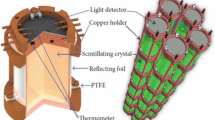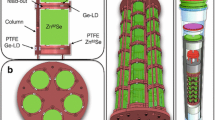Abstract
Bolometers are suitable detectors for fundamental physics experiments, like neutrinoless Double Beta Decay, because of their very good intrinsic characteristics (high detection efficiency, excellent energy resolution, ...). The bolometric technique has already obtained excellent results on the neutrino mass study with Cuoricino, the ancestor of CUORE, an array of 19 towers with 52 crystals each, which will achieve a sensitivity below 100meV. Cuoricino has also shown that the surface contaminations of materials facing the detectors would be the limiting factor for the sensitivity of next-generation experiments with bolometers. Mainly for this reason scintillating bolometers have been developed allowing a very efficient discrimination of alpha particles thanks to their double readout. Excellent results were obtained with different compounds such as CdWO4 , ZnSe and ZnMoO4. Tests performed on these crystals showed the possibility to discriminate the interacting particles through a pulse shape analysis. This feature is very interesting because it allows to obtain the same (or even better) discrimination power achieved with the double readout but with a much easier and cheaper assembly. Finally, the sensitivity that could be achieved with a large mass array of scintillating bolometers is analyzed on the basis of the results obtained on background and energy resolution.
Similar content being viewed by others
References
H. Kraus et al., Radiat. Meas. 42, 921 (2007).
J.W. Beeman et al., Phys. Rev. Lett. 108, 062501 (2012).
A. Strumia, F. Vissani, hep-ph/0606054.
M. Goeppert-Mayer, Phys. Rev. 48, 512 (1935).
W. Furry, Phys. Rev. 56, 1184 (1939).
F. Simkovic et al., Phys. Rev. C 77, 045503 (2008).
O. Civitarese et al., J. Phys. Conf. Ser. 173, 012012 (2009).
J. Menendez et al., Nucl. Phys. A 818, 139 (2009).
J. Barea, F. Iachello, Phys. Rev. C 79, 044301 (2009).
Z. Maki, M. Nakagawa, S. Sakata, Prog. Theor. Phys. 28, 870 (1962).
M. Redshaw et al., Phys. Rev. Lett. 102, 212502 (2009).
C. Arnaboldi et al., Phys. Rev. C 78, 035502 (2008).
E. Andreotti et al., Astropart. Phys. 34, 822 (2011).
C. Arnaboldi et al., Nucl. Instrum. Methods A 518, 775 (2004).
C. Arnaboldi et al., J. Cryst. Growth 312, 2999 (2010).
F. Alessandria, submitted to Astropart. Phys., arXiv:1109.0494.
L. Gironi, J. Low Temp. Phys. 167, 504 (2012).
J.B. Birks, Proc. Phys. Soc. A 64, 874 (1951).
H. Kraus et al., Nucl. Phys. B Proc. Suppl. 173, 168 (2007).
C. Arnaboldi et al., Astropart. Phys. 34, 143 (2010).
V.I. Tretyak, Astropart. Phys. 33, 40 (2010).
C. Arnaboldi et al., Astropart. Phys. 34, 344 (2011).
G. Audi, A.H. Wapstra, C. Thibault, Nucl. Phys. A 729, 337 (2003).
V.V. Alenkov et al., Cryst. Res. Technol. 46, 1223 (2011).
L. Gironi et al., JINST 5, P11007 (2010).
J.W. Beeman et al., Astropart. Phys. 35, 813 (2012).
NEMO3 Collaboration (F. Mauger), J. Phys. Conf. Ser. 203, 012065 (2010).
S. Agostinelli et al., Nucl. Instrum. Methods Phys. Res. A 506, 250 (2003).
L. Gironi et al., Opt. Mater. , 1388 (2009).
C. Bucci et al., Eur. Phys. J. A 41, 155 (2009).
Author information
Authors and Affiliations
Corresponding author
Additional information
This paper is based on the author’s PhD thesis, that was awarded the INFN “Bruno Rossi” Prize in 2011.
Rights and permissions
About this article
Cite this article
Gironi, L. Cryogenic bolometer crystals for rare event searches⋆ . Eur. Phys. J. Plus 127, 84 (2012). https://doi.org/10.1140/epjp/i2012-12084-0
Received:
Revised:
Accepted:
Published:
DOI: https://doi.org/10.1140/epjp/i2012-12084-0




